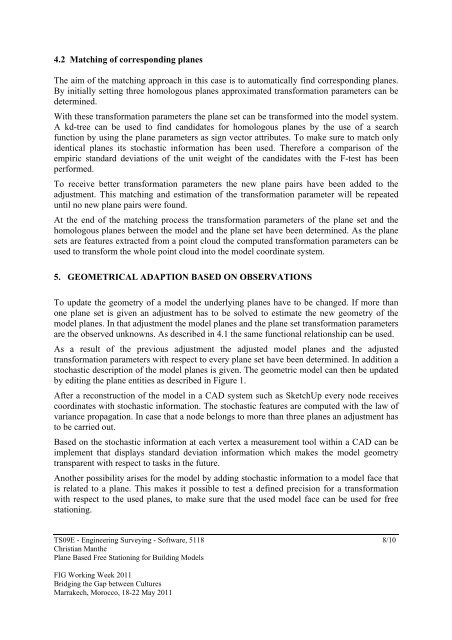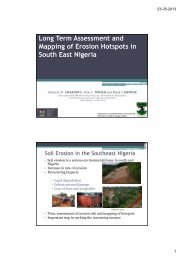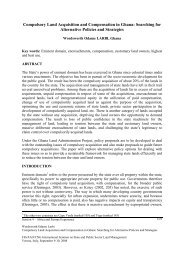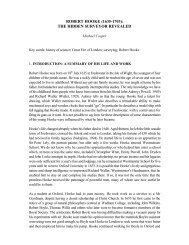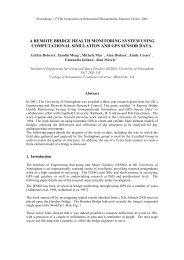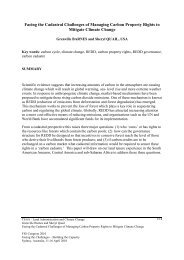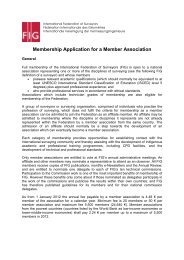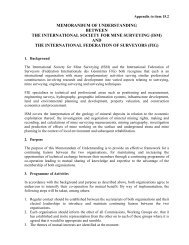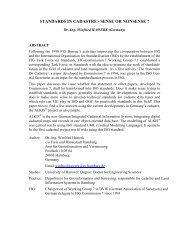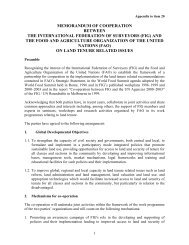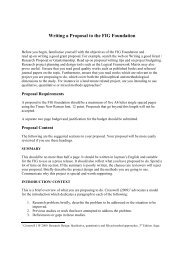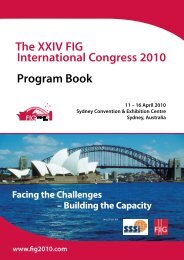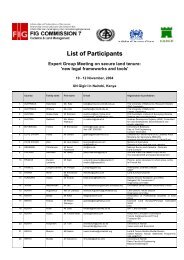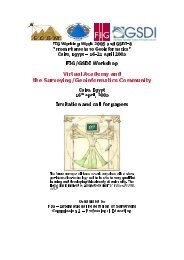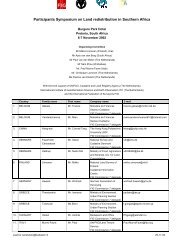Plane Based Free Stationing for Building Models - FIG
Plane Based Free Stationing for Building Models - FIG
Plane Based Free Stationing for Building Models - FIG
Create successful ePaper yourself
Turn your PDF publications into a flip-book with our unique Google optimized e-Paper software.
4.2 Matching of corresponding planes<br />
The aim of the matching approach in this case is to automatically find corresponding planes.<br />
By initially setting three homologous planes approximated trans<strong>for</strong>mation parameters can be<br />
determined.<br />
With these trans<strong>for</strong>mation parameters the plane set can be trans<strong>for</strong>med into the model system.<br />
A kd-tree can be used to find candidates <strong>for</strong> homologous planes by the use of a search<br />
function by using the plane parameters as sign vector attributes. To make sure to match only<br />
identical planes its stochastic in<strong>for</strong>mation has been used. There<strong>for</strong>e a comparison of the<br />
empiric standard deviations of the unit weight of the candidates with the F-test has been<br />
per<strong>for</strong>med.<br />
To receive better trans<strong>for</strong>mation parameters the new plane pairs have been added to the<br />
adjustment. This matching and estimation of the trans<strong>for</strong>mation parameter will be repeated<br />
until no new plane pairs were found.<br />
At the end of the matching process the trans<strong>for</strong>mation parameters of the plane set and the<br />
homologous planes between the model and the plane set have been determined. As the plane<br />
sets are features extracted from a point cloud the computed trans<strong>for</strong>mation parameters can be<br />
used to trans<strong>for</strong>m the whole point cloud into the model coordinate system.<br />
5. GEOMETRICAL ADAPTION BASED ON OBSERVATIONS<br />
To update the geometry of a model the underlying planes have to be changed. If more than<br />
one plane set is given an adjustment has to be solved to estimate the new geometry of the<br />
model planes. In that adjustment the model planes and the plane set trans<strong>for</strong>mation parameters<br />
are the observed unknowns. As described in 4.1 the same functional relationship can be used.<br />
As a result of the previous adjustment the adjusted model planes and the adjusted<br />
trans<strong>for</strong>mation parameters with respect to every plane set have been determined. In addition a<br />
stochastic description of the model planes is given. The geometric model can then be updated<br />
by editing the plane entities as described in Figure 1.<br />
After a reconstruction of the model in a CAD system such as SketchUp every node receives<br />
coordinates with stochastic in<strong>for</strong>mation. The stochastic features are computed with the law of<br />
variance propagation. In case that a node belongs to more than three planes an adjustment has<br />
to be carried out.<br />
<strong>Based</strong> on the stochastic in<strong>for</strong>mation at each vertex a measurement tool within a CAD can be<br />
implement that displays standard deviation in<strong>for</strong>mation which makes the model geometry<br />
transparent with respect to tasks in the future.<br />
Another possibility arises <strong>for</strong> the model by adding stochastic in<strong>for</strong>mation to a model face that<br />
is related to a plane. This makes it possible to test a defined precision <strong>for</strong> a trans<strong>for</strong>mation<br />
with respect to the used planes, to make sure that the used model face can be used <strong>for</strong> free<br />
stationing.<br />
TS09E - Engineering Surveying - Software, 5118<br />
Christian Manthe<br />
<strong>Plane</strong> <strong>Based</strong> <strong>Free</strong> <strong>Stationing</strong> <strong>for</strong> <strong>Building</strong> <strong>Models</strong><br />
<strong>FIG</strong> Working Week 2011<br />
Bridging the Gap between Cultures<br />
Marrakech, Morocco, 18-22 May 2011<br />
8/10


